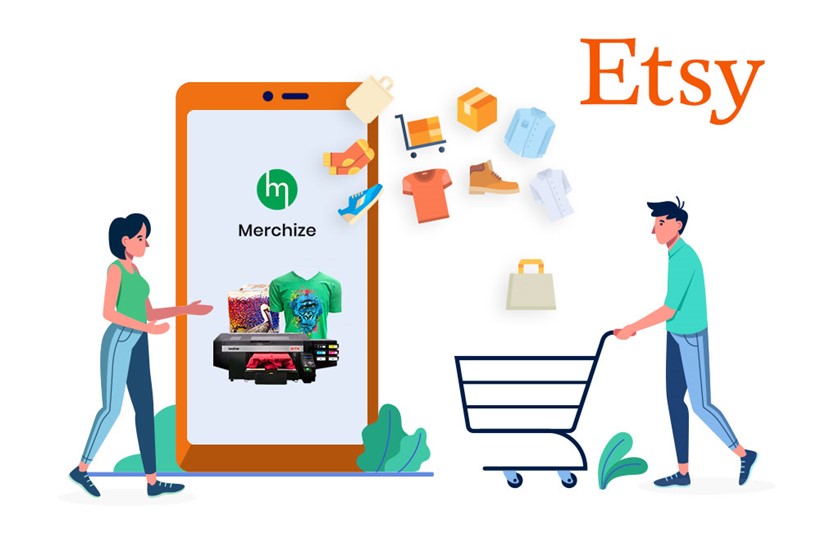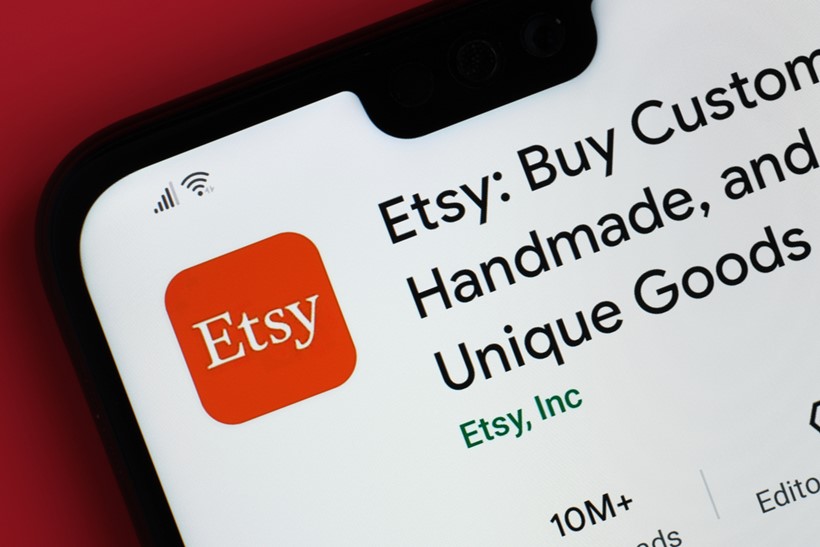Etsy Case Study: Break Down The E-Commerce Success
Etsy, a publicly traded e-commerce marketplace, focuses on connecting buyers to sellers of handcrafted and vintage goods. While notably smaller than the popular e-commerce sites like Amazon or Alibaba, Etsy lives in a slightly different space, carving itself out as a leader among the artist-made and handmade goods marketplace, connecting 2.5 million sellers with nearly 46 million buyers, according to Statista.
In this article, we will unfold the key success factors behind Etsy and take some important e-commerce learning points home with us.
1. Value Creation

Etsy has found a way to create and capture immense value for a variety of reasons. It chose to narrow its product offerings – by only offering handcrafted and vintage goods they were able to carve out a niche and brand for themselves that the Amazons and Alibabas couldn’t beat (as those companies would never be able to claim the title of “the #1 place to go to for artist-made goods”).
On top of that, Etsy creates great value for both sides of its marketplace – sellers and buyers at the same time.
“The heart and soul of Etsy is our global community: the creative entrepreneurs who use Etsy to sell what they make or curate, the shoppers looking for things they can’t find anywhere else, the manufacturers who partner with Etsy sellers to help their individual businesses grow, and the Etsy employees who maintain and nurture our marketplace” – About Etsy
For sellers, Etsy offers a way for artists to earn a living, sell their goods globally, connect with a community of other artists, and create a personal brand (e.g. building a virtual “store”). It also develops a customized help center which plays as a knowledge hub for small business owners and independent sellers to learn tips and tricks that help boost their stores’ performances. On another hand, in terms of buyers, Etsy offers the largest variety of handmade goods, delivery from anywhere in the world, and personalized recommendations through Etsy’s algorithms.
Etsy also offers additional services, in which some are for free, others for a charge, that include easy communication with sellers, conduct the transaction on the platform, access to ratings and reviews and so on.
Based on those values and interactions, Etsy is able to build its smart revenue model: It charges sellers a listing fee and a commission and upsells advertising services such as SEO of a seller’s items to reach more customers.
2. Social Responsibility
Etsy engages in the mission that is to empower micro-entrepreneurs with a voice against local and federal government. That said, Etsy has gone on the advocacy front in order to assist small entrepreneurs who specialize in creative and crafting – the extent to which only a few businesses dare to do.
Etsy has a dedicated team in the U.S. and Europe that focuses on advocating for policy reforms that make it easier for sellers and other microentrepreneurs to do businesses. In September 2016, Etsy brought dozens of sellers to Washington D.C. to meet face-to-face with congress members on the issues that directly affect their businesses.
They also take progressive stances on pressing issues, such as their proposals to create economic security for all, especially those who fall outside the traditional employer-employee relationship. This has not only proven the company’s commitment to a better society, but also a call for more entrepreneurs to join their network – as they know Etsy would probably do anything in its power to protect their benefits and rights.
3. Technology

Being an e-commerce platform provider, Etsy’s major success lies in its relationship with technology. In an interview with TechCrunch, Etsy’s CTO at the time – Kellan Elliott-McCrea shares that the company wants to have as much control as possible over every aspect of the technology stack. While it doesn’t make its own hardware as Facebook does, it does carefully analyze each technology decision.
“One thing that’s inevitable is change. We haven’t figured out every solution and probably will never do. Sometimes the things we think are true will be wrong the next day, and vice versa.” Elliott-McCrea said. And that’s why Etsy is determined to build learning into its technology and committed to innovate its processes without end.
3.1. Advance in buying and selling software
Following such a commitment, Etsy makes programmers one of the biggest portions in its headcount.These programmers are in charge of maintaining Etsy’s website, but also for increasing its usability. E-commerce sites invest huge amounts of money to make sure that their websites are usable for their consumers and encourage those consumers to buy more.
Specifically, Etsy’s website ensures ease of use for sellers to get their products online through various online optimization initiatives. Certain aspects of Etsy’s website are also customizable for sellers that want to make their online shops more personalized to their businesses. As technology evolves, this personalization could be an important differentiation between Etsy and other websites that offer sellers the ability to have their own stores online.
3.2. Investment in machine learning
Creating a platform that enables shoppers to navigate more than 40 million unique listings – which all contain unstructured data – creates complex challenges, especially when it comes to building an engaging and effective search experience. This is why Etsy has invested to expand machine learning capabilities.
“In 2015 we made discovery easier with Exploratory Search, a feature that creates a more visual and engaging experience, particularly on mobile and allows shoppers to browse across various categories. This enhancement increased click-through rates by 10%”
In September 2016, Etsy acquired Blackbird Technologies, a team heavy into Deep Learning and Artificial Intelligence. “We plan to leverage their advanced technology to deliver even more relevant search results and a shopping experience that can be even more tailored to individual buyers”.
3.3. Additional merchant services
One of the more recent advances that Etsy has put into place is the use of its credit card reader service. This service has an additional cost, much like any brick-and-mortar retailer would have to pay. This enables buyers to purchase goods easier, but it also puts some pressure on sellers, as this service comes at additional cost to the seller. This cost can be included in the price of the product, but that would take the seller changing the price for all of that product instead of one instance of the product.
For example, if a seller has a quantity of five of one item, the price needs to change on the whole listing, whether or not one of the quantity is being sold in person using the credit reader. This means the cost has to be absorbed somewhere else, or the seller needs to make a new listing for the in-person sale. Of course, Etsy gets paid for every new listing, so to some extent this is intentional on behalf of Etsy to generate additional earnings from its merchant services. Up till now, this strategy is still effective to Etsy’s model.
3.4. Convenient distribution channels
One of the supposed advantages of buying online is the fact that it eliminates many of the costs of distribution. In a traditional store, the item has to be made at a manufacturer, shipped to a wholesaler, shipped from that wholesaler to a store, and from there to the consumer. The price of this shipment and the rates at which the manufacturer and wholesaler sell goods and services falls onto the consumer. In an online store, originally, the middleman was cut out.
Today, big box stores like Amazon have wholesalers contracted to sell the items, so the cost of that again falls on the consumer. There is simply more negotiation of prices between Amazon and wholesalers because they have choices from which wholesaler to choose from. This has never been the case with Etsy, because Etsy sells products directly from an artist to a consumer through a nearly automated online process.
In a time before e-commerce, big-name artists would go through a gallery as if the gallery were the wholesaler, but local artisans would simply sell locally. Etsy caters more towards those local artisans than big-name artists that are represented by a gallery, so again this is not an issue that applies to Etsy, though it applies to many e-commerce websites.
3.5. Improve social media presence
Etsy has a huge social media following, simply because it promotes small web-based businesses that already rely on social media for marketing. Etsy has been trying to compete on other mobile and social technologies, such as mobile purchases and purchases linked through other websites, including Facebook. Thereby, Etsy began developing apps for mobile devices by separating the development teams into mobile and web and decided to distribute mobile responsibility across the team instead of isolating it to come up with more efficient initiatives and compete better.
Anyhow, the advancement is not only technology but also strategy has increased the social media access of Etsy, without any shadow of a doubt.
3.6. Implement lean technological process
Another way Etsy drives the commitment to technological efficiency is by limiting the number of tools it uses as a company. It would rather be the master of few tools than have a broad knowledge across many different ones. They said in an interview:
“We want to give people the time and space to really go deep and to understand these tools. That means being able to pop open the hood and look inside and make changes and not run into a wall where you can’t fix a bug in the kernel or database”
They also came to explain: “We are a strong PHP shop. We used to use a wide variety of technologies, now we use a handful. We use PHP, JavaScript, Scala, but we went from a large number of languages to a small number of languages – and we are really good at PHP,” he explained.
One thing this level of expertise has allowed them to do is to partner with Facebook (another big PHP shop) to help transfer a significant piece of its internal infrastructure to the Hip Hop Virtual Machine (HHVM), which improves performance and speeds up coding and development when using PHP.
Elliott-McCrea, Etsy’s CTO at the time, reports that his company is now a major contributor to HHVM because the expertise it has built up allowing it to be fully involved in its development.
“We don’t treat technology as something off the rack. It’s about mastering your tools and that’s something that’s a recurring theme, and again mastering your tools, improving them and then giving back,” he said.
To that end, Etsy has built and contributed many tools to open source – much like Netflix, Facebook, and Google. This not only allows others to take advantage of those tools but also potentially to improve upon them.
4. Sustainability

We have done a lot talking about the strategy, the model, and the technology that crafts Etsy’s success in a market full of giant corporations like Amazon and Alibaba. But the question is: How sustainable is Etsy’s model?
Several factors definitely work in its favor. For example, by providing free shipping from sellers around the world, Etsy was able to build a strong global cluster; this drew more sellers and users and deepened the moat against competitors as Etsy made it hard to break into that type of network.
Etsy has also done a decent job of de-risking disintermediation. They’ve done so by offering many add-on services to sellers (advertising, the ability to open a virtual shop and so on) and invested in technology and resources to create a better shopping and selling experience.
While Etsy has a pretty negligible cost of adding more users while decreasing its barriers to entry, it has found itself with a high repeat buyer rate. By focusing on high-quality user experience, Etsy has established itself as the place to go to buy/sell these types of goods.
More so, Etsy has also been accelerated by the pandemic. During the pandemic and the large-scale lockdown, lots of people needing masks start turning to online e-commerce platforms to make purchases. And Etsy, being a market for such things, surges at an aggressive rate. This is not a one-time bump, however, but potentially more sustainable, making Etsy competitive in the long-run. In its 2020 Q3 Earnings Call, their mere growth from sales on their platform was nearly 150%, in which the non-mask sales (all things that aren’t related to masks) remain growing over 93%. Therefore, even taking the very clear immediate impact of mask sales out of Etsy’s business, it is still a really strong platform.
Etsy had been a strong business before the pandemic and it’s going to be a strong one after.
5. Case Recap
The success recipe of Etsy comes from 3 important pillars: value creation, social responsibility and application of technology.
| Value creation |
|
| Social responsibility |
|
| Technology |
|
Such success is predicted to be sustainable, especially after the boost of COVID-19:
- Provide free shipping from sellers around the world, thus building a strong global cluster and drawing more sellers and users → Deepen the moat against competitors.
- De-risking disintermediation by offering many add-on services to sellers, investing in technology and resources to create a better shopping and selling experience → High repeat buyer rate.
- The pandemic accelerates mask purchases, which will potentially be translated into other non-mask buyers in the future.
In case you are looking for a partner to equip you with top-notch e-commerce initiatives, feel free to contact us – a tech consultant who has been in the industry for 11 years and has been verified for a creative mindset, strong commitment, and outstanding skills. We promise to not only deliver the best social app ideas to accelerate your business but are also capable of translating those initiatives into a seamless and competitive final product.
We also have many other detailed Case Study Analysis like Grab Case Study, Sephora Case Study, Tinder Case Study if you wish to research more.
From Tech Consulting, Mobile App Development Services, Web App Development Services to #1 Vietnam outsourcing software service! Since 2009, Savvycom has been harnessing digital technologies for the benefit of businesses, mid and large enterprises, and startups across the variety of industries. Savvycom dedicated software development team can help you to build high-quality custom software development services and products as well as deliver a wide range of related professional services.
Savvycom is right where you need. Contact us now for further consultation:
- Phone: +84 24 3202 9222
- Hotline: +1 408 663 8600 (US); +612 8006 1349 (AUS); +84 32 675 2886 (VN)
- Email: [email protected]



